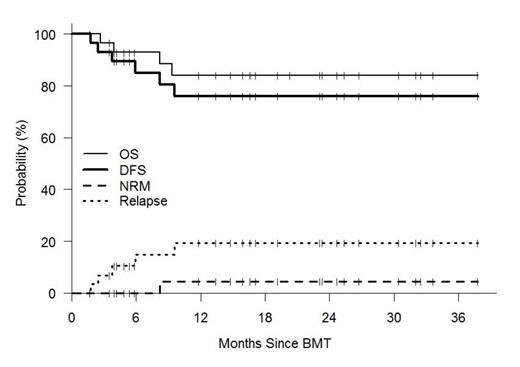Abstract

Lack of a matched sibling or unrelated donor (MUD) can be a significant barrier to allogeneic transplantation in patients who stand to benefit from this procedure. HLA-haploidentical (haplo) donors are readily available for nearly all such patients. Haplo transplantation has inherent advantages over MUD transplantation including the lower cost of graft acquisition, greater availability of donors for ethnic minorities, and immediate access to the donor in patients in whom delay is undesirable. We enrolled a total of 30 patients on a prospective phase II trial utilizing a TBI-based myeloablative preparative regimen (fludarabine 25 mg/m2/d x 3 d and TBI 150 cGy bid on d -4 to -1 [total dose 1200cGy]) followed by infusion of unmanipulated peripheral blood stem cells (PBSC) from a haploidentical family donor. Post-grafting immunosuppression consisted of Cy 50mg/kg/day on days 3 and 4, MMF through d 35, and tacrolimus through d 180. Median patient age was 46.5 years (range 24-60). Transplant diagnosis included AML [16], ALL [6], CML [5], MDS [1] and NHL [2]. Using the recently published Dana Farber disease risk index (DFDRI), patients were classified as low [4], intermediate [12], high [11], and very high [3] risk. No patient experienced graft failure, with a median time to neutrophil and platelet recovery of 16 and 25 days, respectively. All evaluable patients achieved sustained complete donor T cell and myeloid chimerism by Day +30. Acute GVHD, grades II-IV and III-IV, was seen in 44% and 24% respectively. The cumulative incidence of chronic GVHD was 57% (severe in 7%). After a median follow-up of 17 months, the estimated 2-year overall survival (OS), disease-free survival (DFS), non-relapse mortality (NRM), and relapse rate was 84%, 76%, 5%, and 19%. Two-year DFS and relapse rate in patients with low/intermediate risk disease was 100% and 0% respectively, compared with 44% and 46% for patients with high/very high risk disease. When compared with a contemporaneously treated cohort of patients at our institution receiving myeloablative MUD transplantation, outcomes were statistically similar with 2-yr OS and DFS being 84% and 76% respectively after haplo transplant vs. 70% and 62% respectively after MUD transplant. In patients with DFDRI low/intermediate risk disease, 2-yr DFS was superior following haplo compared with MUD transplants (100% vs. 73%, p=0.042), whereas there was no difference in DFS in patients with high/very high risk disease (44% vs. 35% for haplo and MUD respectively, p=0.898). Grade II-IV acute GVHD was seen less often following haplo compared with MUD transplant (44% vs. 63%, p=0.052), as was moderate-to-severe chronic GVHD (21% vs 61%, p=0.004). Myeloablative haplo transplantation is a valid option for patients with advanced hematologic malignancies who lack timely access to a conventional donor. It may provide a benefit over MUD transplantation due to more rapid access to donors, lower graft acquisition costs, less GVHD, and at least equivalent DFS.
No relevant conflicts of interest to declare.
Author notes
Asterisk with author names denotes non-ASH members.

This icon denotes a clinically relevant abstract



This feature is available to Subscribers Only
Sign In or Create an Account Close Modal